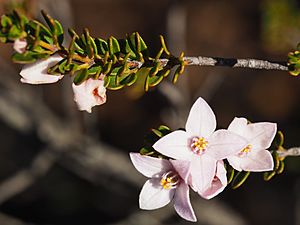Rough boronia facts for kids
Quick facts for kids Rough boronia |
|
|---|---|
 |
|
| Boronia scabra near Ravensthorpe | |
| Scientific classification | |
 |
|
| Occurrence data from Australasian Virtual Herbarium |
The Rough Boronia (Boronia scabra) is a pretty plant that belongs to the citrus family, called Rutaceae. You can only find it growing naturally in the south-west part of Western Australia. It's a small, open bush with simple leaves that often grow in groups. Its flowers are usually pink and have four petals.
What Does It Look Like?
The Rough Boronia is a shrub that can grow up to about 60 cm (24 in) tall. Its branches have soft hairs on them. The leaves are narrow and shaped like an oval, with their edges curving downwards. They are about 5–12 mm (0.20–0.47 in) long and often grow in small bunches.
The flowers grow in small groups at the ends of the branches. Each flower sits on a tiny stalk, called a pedicel, which is about 2–20 mm (0.079–0.79 in) long. Each flower has four, sometimes five, triangle-shaped or egg-shaped sepals. Sepals are like small leaves that protect the flower bud. These sepals are about 2–6 mm (0.08–0.2 in) long.
The plant also has pink, egg-shaped petals that are about 5–8 mm (0.2–0.3 in) long. Inside the flower, the stamens (which make pollen) are a bit swollen at the top. The stigma, which collects pollen, is very tiny. You can see these flowers blooming from July to December.
Its Name and History
The Rough Boronia, Boronia scabra, was first officially described in 1839. A scientist named John Lindley wrote about it in a book called A Sketch of the Vegetation of the Swan River Colony. The second part of its name, scabra, comes from a Latin word. It means "rough" or "scabby," which probably describes how some parts of the plant feel.
In 1998, another scientist, Paul Wilson, found that there are three slightly different types of Rough Boronia. These are called "subspecies." The Australian Plant Census recognizes all three:
- Boronia scabra subsp. attenuata: This type sometimes has five sepals and petals on its flowers.
- Boronia scabra subsp. condensata: This type has rough parts on its stamens.
- Boronia scabra subsp. scabra: This type has smooth parts on its stamens.
Where It Grows
Each subspecies of Rough Boronia grows in different places in Western Australia:
- Subspecies attenuata likes to grow among granite rocks. You can find it at Cape Le Grande and on the nearby Recherche Archipelago of islands.
- Subspecies condensata grows near Badgingarra, often in gravelly soil.
- Subspecies scabra is found in many different places. These include jarrah forests and areas of kwongan (a type of shrubland). It grows between Geraldton, Gingin, Woodanilling, the Stirling Range, and Cape Arid National Park.
How It Is Protected
The Western Australian Government's Department of Parks and Wildlife keeps track of how many of these plants are left.
- Subspecies scabra is considered "not threatened," which means there are plenty of them.
- Subspecies attenuata is listed as "Priority Three." This means it's not very well known and only found in a few spots, but it's not in immediate danger.
- Subspecies condensata is listed as "Priority Two." This means it's also not well known and found in only one or a few places, so it needs a bit more attention to make sure it stays safe.

